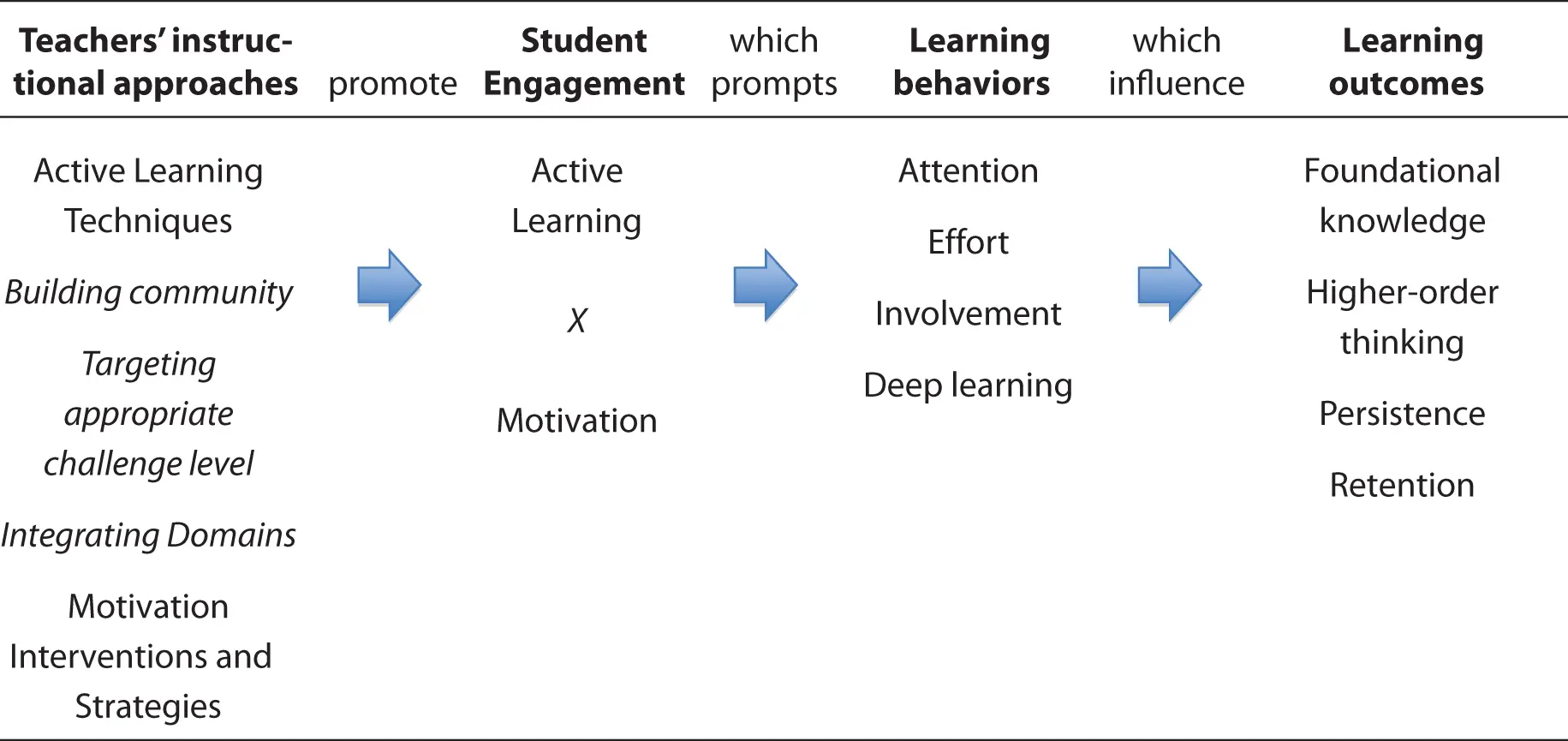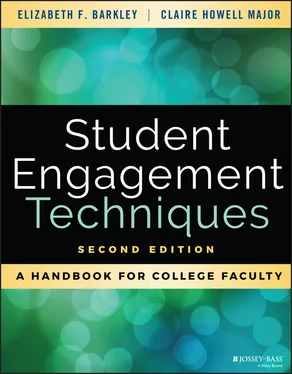Elizabeth F. Barkley - Student Engagement Techniques
Здесь есть возможность читать онлайн «Elizabeth F. Barkley - Student Engagement Techniques» — ознакомительный отрывок электронной книги совершенно бесплатно, а после прочтения отрывка купить полную версию. В некоторых случаях можно слушать аудио, скачать через торрент в формате fb2 и присутствует краткое содержание. Жанр: unrecognised, на английском языке. Описание произведения, (предисловие) а так же отзывы посетителей доступны на портале библиотеки ЛибКат.
- Название:Student Engagement Techniques
- Автор:
- Жанр:
- Год:неизвестен
- ISBN:нет данных
- Рейтинг книги:3 / 5. Голосов: 1
-
Избранное:Добавить в избранное
- Отзывы:
-
Ваша оценка:
- 60
- 1
- 2
- 3
- 4
- 5
Student Engagement Techniques: краткое содержание, описание и аннотация
Предлагаем к чтению аннотацию, описание, краткое содержание или предисловие (зависит от того, что написал сам автор книги «Student Engagement Techniques»). Если вы не нашли необходимую информацию о книге — напишите в комментариях, мы постараемся отыскать её.
— — — —
Student Engagement Techniques
"Student Engagement Techniques
"Student Engagement Techniques
"This book is an essential resource for faculty seeking to better engage with their students. Anyone seeking a clear, research-based, and actionable guide needs a copy of Student Engagement Techniques on their shelf!"
Student Engagement Techniques — читать онлайн ознакомительный отрывок
Ниже представлен текст книги, разбитый по страницам. Система сохранения места последней прочитанной страницы, позволяет с удобством читать онлайн бесплатно книгу «Student Engagement Techniques», без необходимости каждый раз заново искать на чём Вы остановились. Поставьте закладку, и сможете в любой момент перейти на страницу, на которой закончили чтение.
Интервал:
Закладка:
The Psychomotor Domain and Memory
The psychomotor component is also evident in procedural memory, the memory responsible for recalling skills that you've learned over a long time. These kinds of memories are almost impossible to forget because your body and brain have worked so hard to create them. This is the memory that helps you remember how to play a musical instrument or throw a football or button the buttons on your shirt. Novice learners start out imitating the teacher or more advanced peers as they develop skills in taking notes, participating in discussions, and performing laboratory procedures. As they move toward being experts, they become increasingly capable of doing these well on their own, ultimately attaining an unconscious mastery of the skills and often even adapting them in ways that best meet their individual needs.
Acknowledging the role of the psychomotor domain in engagement may be a stretch for many academics, but “the doing” of the visible, auditory, and kinesthetic activities of active learning involve psychomotor skills. “Thinking” and “feeling” are internal, but they are expressed and often “worked out” through talking, writing, reading, and performing actions. At all stages of learning, students with learning styles that respond best to kinesthetic experiences will most be more engaged in learning tasks that incorporate aspects of the psychomotor domain. Finally, teachers know that even the most attentive and well-intended students cannot stay focused when they are sitting idly and physically inactive over long periods of time. Therefore, where possible and appropriate, effective, holistic engagement strategies add psychomotor dimensions, even if it is something as simple as getting students re-energized and refocused by having them stand up and move around the room to talk to each other or find partners for group work.
Integrating the Cognitive, Affective, and Psychomotor Domains
In some fields, experts must be skilled in all three domains. An accomplished classical pianist must be able to read abstract musical notation, memorize thousands of notes, create a unique interpretation by synthesizing what he knows and understands about the piece's historical context with what he believes to be the composer's concept, blend this with his personal artistic vision, and perform physically in a nuanced manner at split-second speed. Similar domain spanning is evident in the work of actors, surgeons, archeologists, athletes, and others. From one perspective, student engagement may be the process and product of spanning domain boundaries and taking advantage, in an intentional way, of the contributions of each.
Many of the current thinkers on education recognize this complexity. Fink (2003) proposed his taxonomy of significant learning because he believed that higher education was expressing a need for new kinds of learning: leadership and interpersonal skills, ethics, communication skills, character, tolerance, and the ability to adapt to change (p. 29). These kinds of learning go beyond the cognitive domain. Shulman's (2002) table of learning involves cognitive, affective, and psychomotor elements and is integrative and cyclical rather than hierarchical. The expanded concepts of Fink (2003) and Shulman (2002) are supported by other new approaches. In “College Learning for the New Global Century: A Report from the National Leadership Council for Liberal Education & America's Promise” (Association of American Colleges and Universities, 2007), for example, the authors urge educators to abandon narrow learning and suggest that essential learning outcomes include knowledge of human cultures and the physical and natural world, personal and social responsibility, and integrative learning.
Arguably, the most effective—and engaging—learning environments integrate domains. The learning activities that teachers design to help students progress cognitively will be most successful if students are engaged on an affective level (they enjoy the tasks and give the tasks their full attention) and, when possible and appropriate, a kinesthetic level (students apply the theoretical and abstract by actually “doing” a physical activity). In our double helix model of engagement, teaching for “holistic” learning can contribute to synergy because it supports active learning (learners are thinking and caring about what they are doing and doing what they are thinking and caring about) and it also enhances motivation (many students find domain-spanning activities intrinsically more interesting and enjoyable, other students find domain-spanning activities necessary to be more successful learners).
Putting It All Together: The Engagement Process
We suggest that teachers can promote student engagement by using active learning techniques and by intentionally striving to increase student motivation. Teachers can promote synergy between the two by building community, targeting the appropriate challenge level, and integrating domains to teach the whole student. Students do their part by investing emotional and intellectual effort into their learning. The combined efforts of teachers and students lead to high-level learning behaviors, which, in turn, are related to improved learning outcomes. We illustrate the engagement process in Figure 4.1.

FIGURE 4.1.Overview of the Engagement Process.
Conclusion
Student engagement is complex, and the model of student engagement as the synergistic interaction between motivation and active learning is simply one contribution to an ongoing discussion of both what student engagement means and how to promote it. Motivation and active learning are twin helices that work together synergistically. Helping students feel as though they are part of a learning community, ensuring as much as possible that students are appropriately challenged, and establishing classroom conditions where students can learn holistically promote synergy because they integrate elements of both motivation and active learning. By looking for ways to contribute to the synergy, teachers can promote increased levels of student engagement. Our understanding continues to evolve and deepen as the dialogue continues. We next turn our attention to how this theoretical model plays out in the practice of the college classroom.
Part Two Tips and Strategies
THE 50 TIPSand strategies that follow build upon the conceptual framework of student engagement we shared in Part One. This framework proposes that student engagement functions as a double helix in which active learning and motivation work together synergistically, building in intensity, and creating a fluid and dynamic phenomenon that is greater than the sum of their individual effects. Engagement does not occur if one of the two elements is missing: if students are motivated but not learning, or if they are learning but doing so reluctantly, they are not engaged. Experienced on a continuum from barely to deeply engaged, students become more engaged as motivation and active learning build. Certain conditions promote synergy because they integrate elements of both. For example, students become more engaged when they feel that they are valued members of a learning community; when they are working at their optimal level of challenge—neither bored nor overwhelmed—and when they are learning holistically. The Tips and Strategies we share in this part come primarily from the literature on teaching and learning and are organized into categories corresponding to our conceptual framework.
Читать дальшеИнтервал:
Закладка:
Похожие книги на «Student Engagement Techniques»
Представляем Вашему вниманию похожие книги на «Student Engagement Techniques» списком для выбора. Мы отобрали схожую по названию и смыслу литературу в надежде предоставить читателям больше вариантов отыскать новые, интересные, ещё непрочитанные произведения.
Обсуждение, отзывы о книге «Student Engagement Techniques» и просто собственные мнения читателей. Оставьте ваши комментарии, напишите, что Вы думаете о произведении, его смысле или главных героях. Укажите что конкретно понравилось, а что нет, и почему Вы так считаете.












